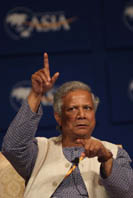|
Du picked his first test site in Yixian County, Hebei Province, an impoverished county with a population of half a million. In 1994, he arranged a US $50,000 low-interest loan from Grameen Bank, an amount matched by the American charitable organization the Ford Foundation, which also provided US $50,000 in free financial aid.
The cooperative followed all the operational procedures of the Grameen Bank, including a requirement that borrowers have five guarantors and set aside an obligatory 5 percent of the loan into a risk fund, as well as a weekly repayment schedule.
The cooperative now owns six test sites, which have invested over RMB 15 million in loan capital, and extended credits worth more than RMB 100 million to over 200,000 rural poor. Still, while the scheme has been more than successful, the organization continues to experience growing pains, as lending practices have had a tendency to vary depending on which local branch has issued a loan.
Staff are not always conversant with modern management practices, and local directors at times disregard the regulations laid down in the organization's founding charter. Ma Yinshan, for instance, once a branch director in Henan Province, ignored employment rules and hired eight of his own relatives in 2000. They, in turn, made numerous irregular loans to earn the RMB 6 commission paid out for every RMB 1,000 of credit issued, and the organization was eventually saddled with RMB 1.24 million of bad debt.
The original intent of Yunus' rural bank had been to offer help to the poorest of the poor. However, that imperative has not always been followed to the letter. "Certain staff members are more inclined to help the relatively poor only, not those who are completely penniless. That might be a rational choice, but it strays somewhat from the original ideal," says Du.
The Bank's Choice
An average household fiduciary loan in rural China amounts to only RMB 3,000, and a joint liability loan totals little more than RMB 10,000 for an individual family, a situation that helps account for the relatively small returns banks receive from their rural lending businesses. As a consequence, state-owned commercial banks began leaving many villages and towns as early as 2000, but as far as Du is concerned. "That is rational behavior by banks in a market economy."
By the end of 2006, there were on average less than three branches of state-owned commercial banks in each township, and over 3,300 villages and towns did not have a single one. In 2007, although some 77.42 million farm households were able to obtain loans, 40 percent of eligible farmers were unable to obtain much-needed credit.
In short, China's rural financial sector was in the doldrums by 2006. For a long time, rural credit associations made up of local shareholders provided the bulk of deposit and loan transactions for farmers.
 |
|
Muhammad Yunus, the Nobel Prize-winning Bangladeshi founder and CEO of the Grameen Bank, which extends micro-credits to the poor. |
|
